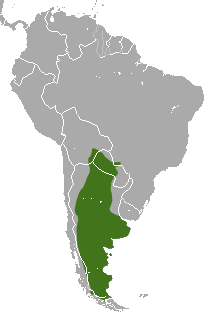Big hairy armadillo
| Big hairy armadillo | |
|---|---|
 |
|
| Scientific classification | |
| Kingdom: | Animalia |
| Phylum: | Chordata |
| Class: | Mammalia |
| Order: | Cingulata |
| Family: | Chlamyphoridae |
| Genus: | Chaetophractus |
| Species: | C. villosus |
| Binomial name | |
|
Chaetophractus villosus (Desmarest, 1804) |
|
 |
|
| Big hairy armadillo range | |
The big hairy armadillo or large hairy armadillo (Chaetophractus villosus) is one of the largest and most numerous armadillos in South America. It lives from sea level to altitudes of up to 1,300 meters across the southern portion of South America, and can be found in grasslands, forests, and savannahs, and has even started claiming agricultural areas as its home. It is an accomplished digger and spends most of its time below ground. It makes both temporary and long-term burrows, depending on its food source. The armadillo can use specially evolved membranes in its nose to obtain oxygen from the surrounding soil particles without inhaling any of the soil itself. Armadillos are protected from predators by a series of thin, bony plates along the head and back. They reach sexual maturity at around 9 months and have been known to live over 30 years in captivity. Though this animal is routinely harvested for its meat and its shell, or simply killed for pestering farmers, it has shown amazing resiliency, and populations seem to be handling this exploitation well. Currently, no protective practices are in place for this armadillo, but it does live in many protected areas. This species of armadillo is a preferred research animal due to its adaptability to laboratory settings, and relative hardiness in situations of stress.
Chaetophractus villosus or the big hairy armadillo is the most abundant species of armadillo in Argentina. The armadillo’s head and body are covered by protective bony plates, with its head plate being the most prominent. Along its back, flexible bands that encircle the torso allow flexibility in this otherwise stiff armor. The underside of this armadillo is densely covered in hair and this trait is how it got its common name. Long, coarse hairs also project from the bony plates, making this armadillo much hairier than other related species. The average individual grows from 26 to 34 cm (10 to 13 in) in body length, 22–40 cm (8.7–15.7 in) in extreme cases, and weighs 2 kg (4.4 lb), with a range of 1–3 kg (2.2–6.6 lb) by the time it reaches maturity. The tail measures 9 to 17 cm (3.5 to 6.7 in) long. Powerful front claws are used for both foraging and avoiding predators.
The genus Chaetophractus consists of two or three species, C. vellerosus (the screaming hairy armadillo), C. nationi (the Andean hairy armadillo, which may actually be a population of C. vellerosus), and C. villosus. These species are recognized by the large amount of hair that extends all over their bodies, but especially on their undersides. The skulls follow the same patterns as other dasypodids, but females exhibit longer bones in the rostrocaudal plane, which is one of the key characteristics that shows the sexual dimorphism of these species. Not much is known about the cranial morphology of these species, especially bone descriptions. More research is being done to better describe these species and the skeletal differences between them. For now, body size, habitat, and behaviors are the best way to discern the differences.
...
Wikipedia

